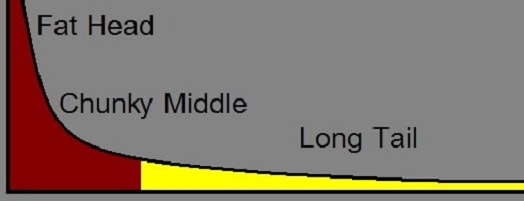What is a Long Tail Keyword?
Long Tail keywords are just less popular keywords. Generally the are made up of three four or more words but not necessarily, as you can have a long tail keyword consisting of just a single word.

They generally also have less traffic. So lets take a look at an example.
So lets start off with a Keyword that is definitely NOT a long tail keyword, often referred to as the Fat Head keyword.
Keyword: “Samsung”

Looking above you can see the keyword “Samsung” is searched for 1 million times per month. The ranking difficulty is enormous. Samsung has a big budget and they have been around for a long time. The chances of someone new putting up a website and ranking for “Samsung” on the first page of Google is just not going to happen. This is a terrible keyword to go after it is way to general, you do not know if someone is searching for a phone, TV or refrigerator. You also have no idea if they have just started researching, are ready to buy something, or just looking at how to configure a product they already have.
So lets take a look at something with a slightly longer tail.
Keyword: “Samsung Galaxy”

As you can see this keyword has about 1/10 of the traffic from the previous Fat Head keyword. Although technically this would be easier to rank for, it is still virtually impossible. There is way too much competition and the established incumbents are to difficult to outrank. Also we still have the issue of not knowing exactly what the user is searching for. Is it to buy a new phone?, Fix their existing phone? See what range of phones are available etc.
So lets head down closer to the long tail by passing through the Chunky Middle.
Keyword: “Samsung Galaxy Note”

As you can see it is searched 22,000 each month, around 1/5 from the previous. Still this is too difficult to rank for. We are focusing down and getting more targeted but we still have some way to go.
Keyword: “Samsung Galaxy Note 5”

So what has happened here? we have added an extra word but the search volume has gone up. This highlights the fact that a long tail keyword is not necessarily a phrase with more words. We have more people searching for the more targeted “Samsung Galaxy Note 5” then we have for the more general “Samsung Galaxy Note”.
Either way it is still too competitive here and we need to go even further if we are ever going to find a low competition keyword that has a chance to be ranked for.
Keyword: “Samsung Galaxy Note 5 Case”

As you can see a lot less traffic at 3,600 searches a month and the keyword competitiveness score has also come down. But this is still far too competitive.
Keyword: “Samsung Galaxy Note 5 Case with Kickstand”

OK so now we have a long tail keyword, it just so happens to be 7 words long. It is very important to note the Avg Keyword Competitiveness score here as it has drooped to below 30.
Conclusion
It is far easier and many times in the realm of possibility to obtain web traffic by going after many less popular long tail keywords. In aggregate you can make up a decent amount of monthly visits. Yes it will require a lot more content.
For the “little guys” do not even think about trying to rank for a keyword unless it has a Avg Keyword Competitiveness of less then 30.
Generally but not necessarily long tail keywords will consist of more words then the Chunky Middle keyword. Generally but not necessarily the fat head keyword will contain less words then the Chunky Middle keyword.

Good keywords are not necessarily high volume. As you can see above generally high traffic keywords mean unfocused, expensive and extremely high competition. Going after a Fat Head keyword will just cost you a lot of money and waste a lot of your time.
Years ago before digital products when books were printed on paper. Music came on records, tapes, and CDS. Movies came on tapes and DVDs. Shelf space was expensive. If you wanted to sell 100 books you would need pay for it to be printed, pay for it to be shipped to you, pay to ave it stored in inventory etc.
Today the shelf space is virtually free it cost next to noting to hold a digital product. There may be a small fee for the transaction and a commission for the platform. If you do it all yourself you can pocket 100% of the profits.
So rather then selling many copies of extremely popular products. Today it is possible to sell fewer copies of many products, because holding digital inventory is virtually free.